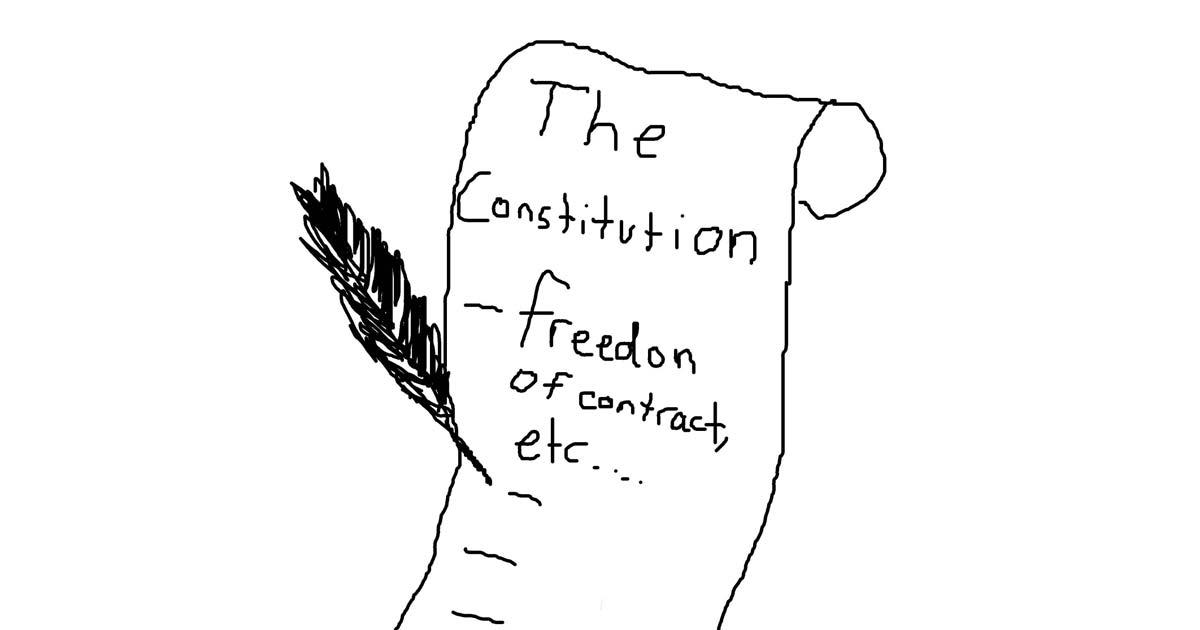On October 25, 2020, 78 percent of Chilean voters went to the ballot box to approve rewriting the country’s constitution, largely viewed as Latin America’s most stable constitution. After nationwide protests kicked off in October 2019, the Chilean left was able to successfully compel President Sebastián Piñera to let Chilean voters decide the fate of the country’s political charter. In the next step, Chileans will decide if the new constitution will now be drafted by a constitutional convention made up of politicians and other elected representatives or a constituent assembly completely made up of citizens. Both options would necessitate a two-thirds majority and must be carried out within a year. Proponents of the constitutional rewrite alluded to the fact that
Topics:
José Niño considers the following as important: 6b) Mises.org, Featured, newsletter
This could be interesting, too:
Nachrichten Ticker - www.finanzen.ch writes Die Performance der Kryptowährungen in KW 9: Das hat sich bei Bitcoin, Ether & Co. getan
Nachrichten Ticker - www.finanzen.ch writes Wer verbirgt sich hinter der Ethereum-Technologie?
Martin Hartmann writes Eine Analyse nach den Lehren von Milton Friedman
Marc Chandler writes March 2025 Monthly
 On October 25, 2020, 78 percent of Chilean voters went to the ballot box to approve rewriting the country’s constitution, largely viewed as Latin America’s most stable constitution. After nationwide protests kicked off in October 2019, the Chilean left was able to successfully compel President Sebastián Piñera to let Chilean voters decide the fate of the country’s political charter. In the next step, Chileans will decide if the new constitution will now be drafted by a constitutional convention made up of politicians and other elected representatives or a constituent assembly completely made up of citizens. Both options would necessitate a two-thirds majority and must be carried out within a year.
On October 25, 2020, 78 percent of Chilean voters went to the ballot box to approve rewriting the country’s constitution, largely viewed as Latin America’s most stable constitution. After nationwide protests kicked off in October 2019, the Chilean left was able to successfully compel President Sebastián Piñera to let Chilean voters decide the fate of the country’s political charter. In the next step, Chileans will decide if the new constitution will now be drafted by a constitutional convention made up of politicians and other elected representatives or a constituent assembly completely made up of citizens. Both options would necessitate a two-thirds majority and must be carried out within a year.
Proponents of the constitutional rewrite alluded to the fact that the current Chilean constitution was ratified in 1980 during the military government of Augusto Pinochet and should be treated as illegitimate. But arguments centering on income equality and the perceived inequities generated by this constitutional order became some of the most salient narratives that dominated the widespread protests. Often overlooked is how under center-left president Ricardo Lagos’s administration (2000–05) the Chilean constitution underwent fifty-four changes.
Pinochet’s John Hancock ended up being removed, and Lagos’s signature replaced his on the national charter in 2005. After leaving his signature on Chile’s national charter, Lagos boldly declared that Chile now had a “democratic” constitution that would “unite all Chileans.” Clearly, this wasn’t enough for leftist protesters in Chile, who remain convinced that Chile’s constitutional order is illegitimate and therefore must be torched.
Chile Is on the Verge of Going down the Road of Wiki-Constitutionalism
Latin America has a rich history of “wiki-constitutionalism,” whereby constitutions are constantly changed almost at will by demagogic leaders or radicalized voters. Make no mistake about it: a decision to embrace “wiki-constitutionalism,” which would likely create a constitution that grants the state more power over Chileans’ economic activity, is the first step toward undoing Chile’s successful economic experiment. Further, a constitutional rewrite would make Chile look like any other Latin American country.
Wiki-constitutionalism has been a hallmark of Latin America since the region gained its independence from Spain in the 1820s. Countries such as the Dominican Republic (39), Bolivia (17), and Venezuela (26) have discarded their respective constitutions on multiple occasions. Thus far, Chile has had eight constitutions, with the current one (ratified in 1980) replacing the Chilean Constitution of 1925.
Overturning an otherwise stable constitutional order will unquestionably put all the progress Chile has made in recent decades at risk. Chile’s past fifty years have been a rollercoaster ride of economic turmoil followed by spectacular economic growth. The early 1970s witnessed Marxist president Salvador Allende completely trash the country’s economy through his enactment of price controls, expropriations, and mass inflation which reached an annual rate of 500 percent.
However, once Allende was deposed in 1973, things started to change. In the intervening years, military dictator Augusto Pinochet wisely turned to the Chicago Boys for economic policy advice. In doing so, the Southern Cone country began to take off. Thanks to the privatization, trade liberalization, and economic control abolition measures that were implemented during the military government, Chile was able to bounce back from the economic nightmare Allende subjected the country to.
What Chile Is Potentially Throwing Away
Furthermore, the Chicago Boys’ influence went beyond Pinochet, as their market reform framework stayed intact under the Concertación coalition of center-left parties that governed the country from 1990 to 2010. As a result of this economic consensus, the per capita income in Chile increased fourfold to $23,000 from 1980 to 2015. Poverty reduction has largely been taken for granted by detractors of the Chilean model.
Chile’s poverty rate fell from about 70 percent in 1990 to under 10 percent in 2018. What’s more, a 2018 study by the Organization of Economic Co-operation and Development (OECD) demonstrated that Chile experienced the highest social mobility of the sixteen OECD member countries.
Flawed Economic Policy at the Root of Chile’s Current Economic Problems
Like any country, Chile has its flaws. From 2014 to 2017, the Chilean economy grew by a measly 1.8 percent, its lowest growth rate since the 1980s. However, the Left misinterprets the country’s economic problems and, even worse, proposes solutions that would aggravate Chile’s present sluggishness. Chile’s recent economic slowdown was largely the result of policies pursued during the administration of Sebastian Piñera and Michelle Bachelet over the last decade.
Piñera’s election in 2010 was initially viewed with great optimism. It represented the first time a right-wing presidential candidate had been able to assume power since the military government stepped down in 1990. Overall, Piñera’s first administration was a mixed bag. It did continue to liberalize trade and reduce barriers to opening business. However, Piñera did have a few sketchy deviations in his first term in office—from raising corporate taxes to trying to appease student protesters in 2013 with government-subsidized scholarships. Chile was left in relatively good shape when Piñera exited the presidency in 2014, but there was a growing radicalization slowly creeping into the political arena during this period.
His successor, Michelle Bachelet (2014–18), was a different story. She implemented a number of measures that strengthened the state’s role in education and empowered labor interests to the point of damaging worker flexibility, while also getting some tax hikes thrown in there for good measure. As a result, Chile began to experience its most significant economic downturn in recent history. Additionally, Bachelet began to sow the seeds for overturning Chile’s constitutional system by criticizing its supposedly tainted origin and inability to address perceived inequities. Once she was out of office, the anticonstitution narrative had already been framed in a decidedly leftist direction.
When Piñera came back to power in 2018, many believed a course correction was in short order. Piñera promised to bring back the glory days of his relatively prosperous first term in office. However, Piñera’s second administration has proven to be a colossal disappointment. Not only did he embrace many of the dubious premises regarding inequality that the Chilean left constantly yammered on about, but he also tried to pacify Chileans by promising to usher in a new “social contract” that consists of minimum wage increases, raising taxes on the rich, and getting the Chilean state more involved in Chile’s pension system.
This was not enough for the hyped-up leftist mobs, who demanded even bigger concessions from Piñera. The pressure was simply too much for the center-right president; he gave in to the mob’s demands and the country is now in the process of dismantling its constitution—arguably the most market-friendly in the region.
Is Chile Doomed?
Everyone’s got their hot take on Chile’s future. Many think it will soon be on its way to becoming the next Venezuela, with hyperinflation and an economy in ruins. If we’re going to draw comparisons, I tend to fall somewhere in the middle. I’m of the opinion that Chile’s path after this referendum may perhaps look more like Venezuela’s gradual decline when it went back to democracy in 1958 and experienced subsequent decades of stagnation and financial reversals until its pivotal 1998 election, which turbocharged the country’s decline. For those who aren’t aware, Venezuela’s erratic development after returning to democracy in the late 1950s was the product of the government’s decision to nationalize the oil industry in the 1970s, politicize its central banking system, and gradually ratchet up its economic interventionism. There was a general sense of optimism after Carlos Andrés Pérez and his successor Rafael Caldera implemented decent economic reforms in the 1990s. However, they could not tame the inflation beast during this period. Venezuela’s economic implosion in the ’90s allowed a demagogue like Hugo Chávez to enter the political scene and take power with relative ease.
Chile Must Go back to Basics
What can Chile learn from this? All is not lost, even when the country is paddling through the waters of institutional uncertainty. We should not buy into the narrative that Chile’s discontent is the product of a failed “laissez-faire” model. Quite the contrary. In a previous article, Victor Espinosa offered a damning analysis of Chile’s detour from its market-based prowess. Outside observers such as the Heritage Foundation have documented Chile’s gradual descent into interventionism. In 2008, Chile was Latin America’s freest economy, as demonstrated by its eighth-place ranking according to Heritage’s Index of Economic Freedom.
By 2020, it had dropped to fifteenth place, largely due to Bachelet’s interventionist drift. The World Bank’s Doing Business Index revealed a similar trend. In Doing Business 2008, Chile was in thirty-third place, but in Doing Business 2020, the Southern Cone country fell to fifty-ninth place. No matter which way market skeptics spin it, we cannot resoundingly assert that Chile’s malaise is because of its free market model. If anything, we’re seeing that the country is not remaining faithful to the very policies that facilitated its rapid growth from the 1970s up until the 2010s.
Neither generous Keynesian spending programs, social democracy, nor resource nationalism will deliver Chile to the promised land. Chile’s fate is by no means sealed nor is it condemned to the path of manmade disasters like Venezuela. Bold leadership can still come in and make things right. But it will require the country to go back to basics and expand upon the market-based reforms that made Chile the envy of the region.
Tags: Featured,newsletter





